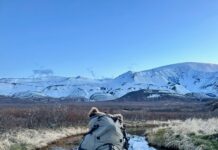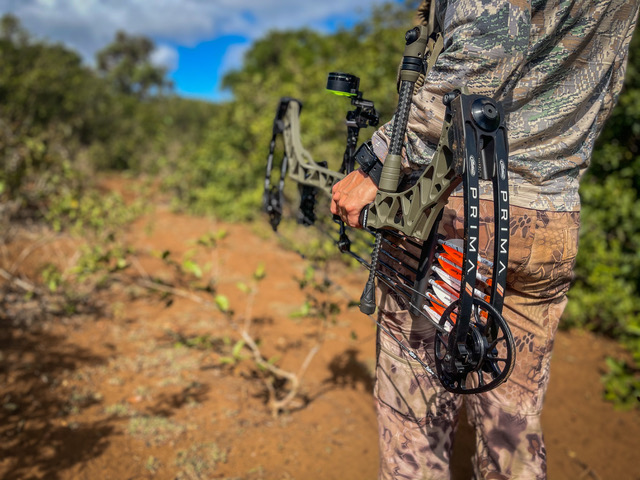
I wanted to start the year off positively and have something to focus on. Covid was really a downer mentally, and I was looking for something new and different that would lift my spirits. I decided to learn how shoot a bow because it’s something that always has been intriguing to me; but I didn’t know much about it. My husband, Travis Bertrand of the Rokslide Staff, and both of my children shoot archery, so I decided it would be a great opportunity to spend more time with my family. I might also start to understand all the archery talk in our household. Travis had told me about the Mathews Prima bow (more on that below) for ladies, and I thought that might be a good fit for my 5’4″ 110lb frame.
The Hunting Grounds
It was late February and my husband Travis and I were planning a trip to Hawaii at the end of May to hunt Axis deer. Although I didn’t yet own a bow, this would be my first bowhunt! I knew that May would creep up on us in no time, so I had to get my butt in gear.
The first thing I did was go to our local archery shop to try some bows and get my draw length figured out. When I went to shoot, I could not believe how challenging it was just to pull back the bow! It took everything I had, even with a release. I knew then that it would take a lot of hard work and time to get me where I wanted to be with archery by the end of May.
Mathews Prima Bow
With recommendations from others, we ordered the Mathews Prima woman’s bow Travis had mentioned. More info here. I jumped on Mathews Bow Builder to look at my options. To my surprise, the Prima is a semi-custom bow, and I could pick out just about everything on it.
I had the choice to choose from quite a few colors–everything from the riser, limbs, and accessories. The website even lets you choose from multiple string colors along with your choice of color of string twist. I spent hours on the website designing my bow.
I chose the Flatline Stabilizer and the Ultrarest MX Arrow Rest with the new integrated attachment system. This is a dovetail on the bow, which makes for a more secure attachment and makes the rest mount much smaller than if I’d chosen the standard Ultrarest. I also chose the Q-Lite Quiver coming in at a paltry 7ozs–the lightest quiver on the market.
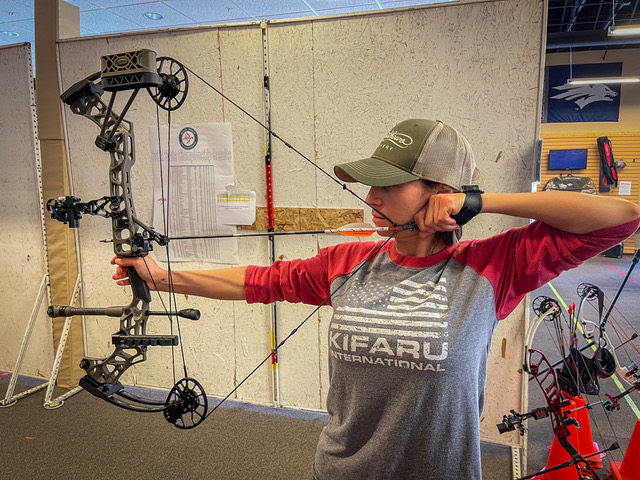
Starting My Archery Journey
Mathews sent a confirmation email that my bow would be a few weeks out as I’d ordered it right at product launch and the Archery Trade Association Convention. There was no time to waste, so I decided to rent a bow and take a lesson at our local indoor range. We did a 1-hour session. My instructor worked with me on posture and other little things to teach me about the shooting process. It was very helpful and made me realize my journey with archery had just begun.
Building Strength
At this time, I also changed my whole workout routine to strengthen my arm and back muscles. I worked out five days a week building upper body mass, and doing other specific exercises targeted for archery. It worked, and after just two-and-a-half weeks, I was able to pull back 42-pounds! Honestly, that was one of the hardest things I had to do with the whole process of shooting archery. It was mentally and physically challenging, but I now had a shot at being able to hunt on our trip.
The Prima Lands
My Prima bow finally arrived. The Prima is a compact bow at 30″ axle-to-axle with a brace height of 5 1/2″ and weight of 3.9 lbs. We’d ordered mine in the 40-50lb draw weight range. We set my new bow poundage to 43 and I could pull it!
This bow can be very fast, especially if you have a longer draw length and can pull back their 60-pound limbs. Mathews advertises 321 FPS at 27.5″ draw length at those specs.
I am at 24.5″, shooting an arrow weight of 370 Grains at 245 FPS with my setup. The 80% let-off helped me hold that weight at full draw (the draw cycle is very smooth with a stiff back wall, more on that later).
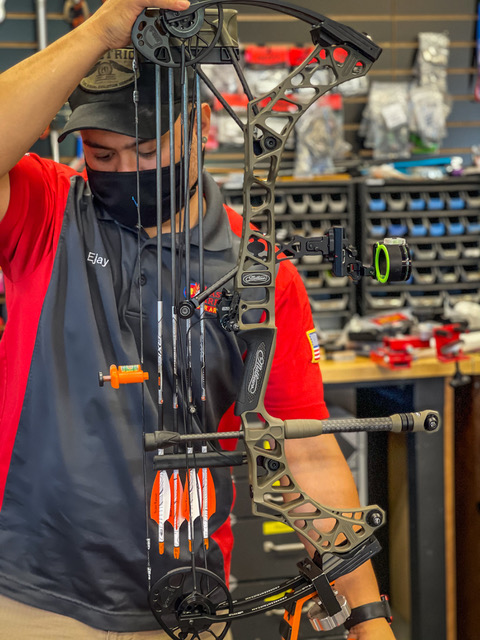
With my Prima in hand, we decided it would be best to take weekly one-on-one lessons. My instructor started by having me shoot blind to get a feel for correct anchor points and releasing the trigger correctly. The Prima started to feel natural for me. After a couple of weeks of getting that down, I was now shooting five days a week in-between lessons.
We then moved back to 20 yards, and I learned how to use the Black Gold five-pin sight. I learned how to pin gap and hold high and low for yardages the pins were not set for. I experimented with my pins for these distances and it was a challenge to hit where I wanted. This was all new to me but having the instructor and a bow I could handle really sped up the process.
Practicing Field Positions
After knowing my sight at different yardages, we started working on shooting positions I might encounter in the field. The short axle-to-axle helped as I learned to practice shooting sitting down and kneeling. Just as important, I learned how to let down my bow if I didn’t shoot. It was hard at first, but the forgiving draw cycle helped. It was very valuable to learn because that may cost you a shot opportunity with a jerky let-down or worse, an unintended arrow release.

As my hunt was getting closer, I was now working on shooting with the clothing I would be wearing in the field. My instructor explained to me how important this was beforehand. I was even shooting with a bino harness on to get comfortable with my complete setup.

Things I Liked
There were several things I really liked about the Prima. First is the shot vibration, or lack thereof. Mathews mapped out the vibrations and placed a bow-specific tuned dampener where it was needed most. The vibration I felt in my hand was much less than other bows, lessening the likelihood of developing a fear of the bow going off (target panic).
Also, as mentioned, the Prima’s draw cycle and strong back wall was really good, and better than the other bows I’d tried. The draw cycle was very smooth and constant. I didn’t feel like I was hitting a point drawing back where it became overly difficult. With the other bows, I noticed the valley was very short. There were a few times at full draw, I accidentally let down other bows! I have not done that with the Prima. The back wall is also very solid making my anchor point more repeatable every time while also helping me pull through my shots.
Next was the ease of tuning. We confirmed that the bow arrived very well tuned. We simply installed the Ultrarest MX Arrow Rest, did some very minor adjustments and soon had arrows flying in excellent tune. Our archery tech also checked cam timing and other tuning stuff that was over my head. It was all dead on. Being a semi custom bow made to order, I wouldn’t expect anything else. Have faith that Mathews makes this part easy, taking tuning nearly out of the equation.

Finally, Mathews custom Bow Builder allowed me to get the exact bow I wanted cosmetically. They have so many options to choose from with many different colors and accessories–they know what ladies like.
Mathews also offers several other grips as well, so you can get the feel that’s right for you.
Things I Didn’t Like
The Prima did feel top-heavy to me. At full draw, it felt as if the weight is at the top of the bow, making it hard to balance. On our Hawaii hunt, I carried the Prima around for four days straight and it started to feel heavy. That could just be my smaller frame but I felt the 3.9lbs for sure. I took out the stabilizer weights from the Flatline Stabilizer to try and save weight, but I noticed I was not near as stable as before when shooting, so I put the weights back.
I also am not a fan of the Q-Lite Quiver. Having a short draw length means I have short arrows, and this quiver does not have an adjustment for arrow length. I could not set my broadheads very deep into the top of the quiver or my fletchings would make contact with the lower portion of the quiver. I should have gone with the Mathews HD Removable Quiver, which appears to be shorter in length.
None of these issues were deal breakers and are related to my small size. I’m surely on the smaller side of sizing for this bow. If I was bigger, the top-heavy feel and the short quiver wouldn’t be a problem. I plan to lengthen my arrows an inch next time we build to rectify the quiver issue. I understand bows are not a one-size-fits all and I imagine this bow would be well suited for any female shooter, especially shooters that do not push the lower limits on sizing for this bow.
Hawaii Axis Deer Hunt
We made it to Hawaii, and I had four days to harvest my first animal. We hunted hard, and I was able to draw back on an animal, but in the end, I did not shoot an arrow. The opportunity for a clean shot just wasn’t there.
I learned a lot about archery and the perishable skills necessary to be successful. Archery is a skill you have to work hard to be proficient at. Both on the target line, and in the field. I plan to continue my journey with archery and hope to be successful in harvesting an animal with my bow in the future.
The Mathews Prima bow made my entry to archery much easier than the other bows I tried. In just a few months, I was proficient enough to go on my first bowhunt. With a good draw cycle, solid back wall, short axle-to-axle, low vibration, and the fact that the bow was easy to tune, I can recommend it to any lady bowhunter. I sure look forward to shooting my Prima in the years to come.
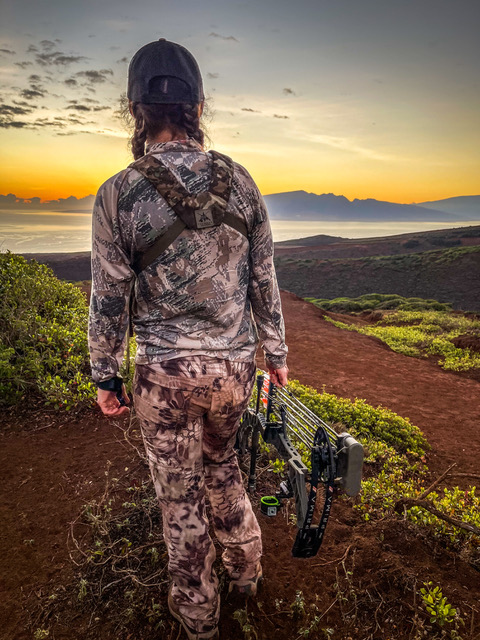
Comment on this article or ask Andrea questions here.
Head over to our achery page to read more archery related articles.
Sidebar
Top Things I Learned and Would Tell a Woman Archer
- Set your bow at a poundage you can handle Even if this means you have to hit the gym for a few weeks to be able to pull your bow back initially. You can add poundage as you gain strength
- Walk or hike with your bow in all of your gear to get a feel for the weight, and different ways to carry it. I didn’t do this enough and I paid for it. You might consider adding Mathews Bow Sling.
- Shoot with all of your gear you will be hunting in, including hat, neck gaiter, bino harness, and jacket, given the season you will be hunting in.
- Choose a sight that you are comfortable with, and applies to the hunt you are going on. While I practiced with a multiple-pin sight., I hunted with a single-pin slider. Now that I realize how much Axis deer move, I would have been better off with a multiple-pin sight.
- Practice a lot with drawing your bow, holding it back, and then letting it down in multiple positions. Do this in safe place with an arrow knocked so you don’t accidentally dry-fire your bow. Also practice this in the field, especially if you are in a spot where you are trying to ambush an animal. This will ensure you have clear shooting lanes, and you are comfortable with the shot if it comes.
- Go to your local shop and get a few lessons. This is money well spent. Without the help of Ejay at Wasting Arrows, I would not have felt confident going into my hunt. He started me off right and made sure I was not starting with any bad habits. He gave me a great foundation to work off of for my future archery endeavors.














